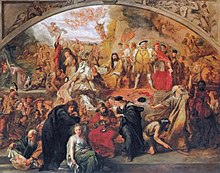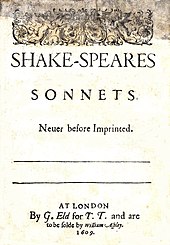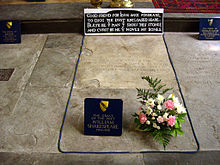Most playwrights of the period typically collaborated with others at some point, and critics agree that Shakespeare did the same, mostly early and late in his career.
[70] Some attributions, such as
Titus Andronicus and the early history plays, remain controversial, while
The Two Noble Kinsmen and the lost
Cardenio have well-attested contemporary documentation. Textual evidence also supports the view that several of the plays were revised by other writers after their original composition.
The first recorded works of Shakespeare are
Richard III and the three parts of
Henry VI, written in the early 1590s during a vogue for historical drama. Shakespeare's plays are difficult to date, however,
[71] and studies of the texts suggest that
Titus Andronicus,
The Comedy of Errors,
The Taming of the Shrew and
The Two Gentlemen of Verona may also belong to Shakespeare’s earliest period.
[72] His first
histories, which draw heavily on the 1587 edition of
Raphael Holinshed's Chronicles of England, Scotland, and Ireland,
[73] dramatise the destructive results of weak or corrupt rule and have been interpreted as a justification for the origins of the
Tudor dynasty.
[74] The early plays were influenced by the works of other Elizabethan dramatists, especially
Thomas Kyd and
Christopher Marlowe, by the traditions of medieval drama, and by the plays of
Seneca.
[75] The Comedy of Errors was also based on classical models, but no source for
The Taming of the Shrew has been found, though it is related to a separate play of the same name and may have derived from a folk story.
[76] Like
The Two Gentlemen of Verona, in which two friends appear to approve of rape,
[77] the
Shrew's story of the taming of a woman's independent spirit by a man sometimes troubles modern critics and directors.
[78]
Shakespeare's early classical and Italianate comedies, containing tight double plots and precise comic sequences, give way in the mid-1590s to the romantic atmosphere of his greatest comedies.
[79] A Midsummer Night's Dream is a witty mixture of romance, fairy magic, and comic lowlife scenes.
[80] Shakespeare's next comedy, the equally romantic
Merchant of Venice, contains a portrayal of the vengeful Jewish moneylender
Shylock, which reflects Elizabethan views but may appear derogatory to modern audiences.
[81] The wit and wordplay of
Much Ado About Nothing,
[82] the charming rural setting of
As You Like It, and the lively merrymaking of
Twelfth Night complete Shakespeare's sequence of great comedies.
[83] After the lyrical
Richard II, written almost entirely in verse, Shakespeare introduced prose comedy into the histories of the late 1590s,
Henry IV, parts 1 and
2, and
Henry V. His characters become more complex and tender as he switches deftly between comic and serious scenes, prose and poetry, and achieves the narrative variety of his mature work.
[84] This period begins and ends with two tragedies:
Romeo and Juliet, the famous romantic tragedy of sexually charged adolescence, love, and death;
[85] and
Julius Caesar—based on Sir
Thomas North's 1579 translation of
Plutarch's Parallel Lives—which introduced a new kind of drama.
[86] According to Shakespearean scholar James Shapiro, in
Julius Caesar "the various strands of politics, character, inwardness, contemporary events, even Shakespeare's own reflections on the act of writing, began to infuse each other".
[87]
In the early 17th century, Shakespeare wrote the so-called "
problem plays"
Measure for Measure,
Troilus and Cressida, and
All's Well That Ends Well and a number of his best known
tragedies.
[88] Many critics believe that Shakespeare's greatest tragedies represent the peak of his art. The titular hero of one of Shakespeare's most famous tragedies,
Hamlet, has probably been discussed more than any other Shakespearean character, especially for his famous
soliloquy "
To be or not to be; that is the question".
[89] Unlike the introverted Hamlet, whose fatal flaw is hesitation, the heroes of the tragedies that followed, Othello and King Lear, are undone by hasty errors of judgement.
[90] The plots of Shakespeare's tragedies often hinge on such fatal errors or flaws, which overturn order and destroy the hero and those he loves.
[91] In
Othello, the villain
Iago stokes Othello's sexual jealousy to the point where he murders the innocent wife who loves him.
[92] In
King Lear, the old king commits the tragic error of giving up his powers, initiating the events which lead to the murder of his daughter and the torture and blinding of the Earl of Gloucester. According to the critic Frank Kermode, "the play offers neither its good characters nor its audience any relief from its cruelty".
[93] In
Macbeth, the shortest and most compressed of Shakespeare's tragedies,
[94] uncontrollable ambition incites Macbeth and his wife,
Lady Macbeth, to murder the rightful king and usurp the throne, until their own guilt destroys them in turn.
[95] In this play, Shakespeare adds a supernatural element to the tragic structure. His last major tragedies,
Antony and Cleopatra and
Coriolanus, contain some of Shakespeare's finest poetry and were considered his most successful tragedies by the poet and critic
T. S. Eliot.
[96]
In his final period, Shakespeare turned to
romance or
tragicomedy and completed three more major plays:
Cymbeline,
The Winter's Tale and
The Tempest, as well as the collaboration,
Pericles, Prince of Tyre. Less bleak than the tragedies, these four plays are graver in tone than the comedies of the 1590s, but they end with reconciliation and the forgiveness of potentially tragic errors.
[97] Some commentators have seen this change in mood as evidence of a more serene view of life on Shakespeare's part, but it may merely reflect the theatrical fashion of the day.
[98] Shakespeare collaborated on two further surviving plays,
Henry VIII and
The Two Noble Kinsmen, probably with
John Fletcher.
[99]










